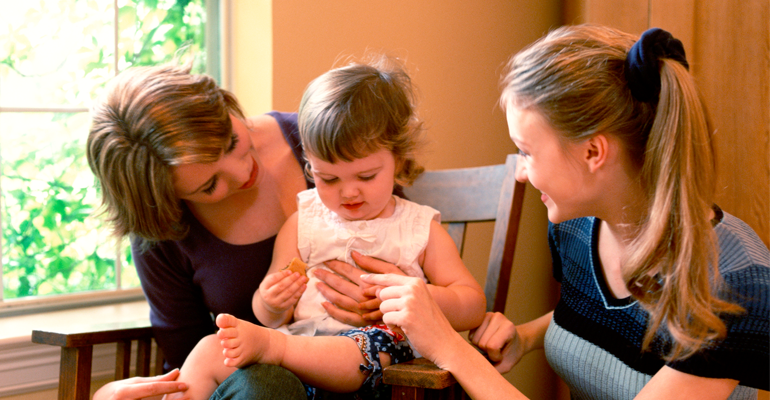My son was three weeks old when I had my first visit. Physically, I was still unaccustomed to my post-pregnancy body and was still healing from a C-section. Emotionally, I was just beginning a heart-wrenching journey into the loss of my son. I was brittle with grief.
Earlier in the day I had been to court to sign away my parental rights. While the judge was as gentle as he could be, the language of relinquishment hung heavy in the air. I was giving up all “rights and responsibilities” from this day forward. I was to “be as a stranger” to my son.
While I understood that I no longer had any legal responsibilities to him, I knew I had a moral responsibility. I was determined that, even though I was no longer parenting, I would not “be as a stranger” to him. Visiting my son that day was an affirmation of the decision I made to have an open adoption, despite the legal language of adoption.
Did I really need to see my son being mothered by another? Did I really want to walk into a house I could never afford and see the stability I felt I could never provide? The answer to both questions is a resounding yes! At that time, was visiting the most comfortable thing for me to do? Absolutely not. But even then, I knew that comfort is not what this “open adoption stuff” should be about.
Open adoption is not designed to make the adults involved comfortable; it is about providing for the needs of a child. Much of the open adoption experience is awkward, especially in the beginning. Many birth parents in the crisis of planning for an adoption, or in the throes of grieving, look upon continuing contact as too painful to contemplate.
Many adoptive parents just want to be a family, without the added complication of visits with their child’s birth family. Open adoption agreements that are guided by these feelings that occur around the time of placement do not allow contact to ebb and flow according to the needs of all involved, most importantly the child.
Adoption is a lifelong process. As time goes on, birth parents, adoptive parents, and the child often find they want more contact, but feel they are not able to ask for more because of the original agreement. If the child is to be the primary beneficiary of open adoption, we need to see open adoption as a covenant instead of a contract or agreement.
In Webster’s Revised Unabridged Dictionary, “covenant” is defined as one of the strongest and most solemn forms of contract. It is also described as sacred. For open adoption to work best, birth parents and adoptive parents need to see their involvement with each other as a sacred commitment, a covenant they make to each other for the sake of the child.
Patricia Martinez Dorner, author of Children of Open Adoption and Talking to Your Child about Adoption, encourages us to see open adoption as another form of blended family. In adopting, adoptive parents are welcoming the member of one family into their own. When birth family are accepted as extended family members, it gives the child a sense of wholeness.
Children in these situations do not have to worry about “splitting their loyalties” between two families, because they come to see their adoptive family and their birth family as one. In the early years in particular, birth parents and adoptive parents take up the responsibility of maintaining connection with each other. A toddler or a child cannot carry the burden of connecting his two families.
An adopted child whose birth family and adoptive family come together in a positive way will grow up with greater certainty. There is a saying that the greatest gift parents can give their children is to love one another. I think this applies not just to married couples, but to all parents.
Putting the open adoption covenant into practice
Treat each other as the family members you are. You don’t have to spend every holiday together, but, at the very least, you should find ways of remembering each other on holidays and birthdays. There is a tendency in open adoption to create artificial boundaries that one would never dream of imposing on other family members, friends, or even acquaintances. When considering the contact you are going to have with each other, instead of asking “Why?” ask “Why not?”
Honor each other. In addition to sending each other Mother’s Day and Father’s Day cards, birth parents and adoptive parents can honor the unique roles that they have in the child’s life. For birth parents this means supporting and respecting the parental decisions that their child’s adoptive parents make. For adoptive parents it means acknowledging the similarities that your child shares with his or her birth family, as well as encouraging the birth family to share family history and pre-placement history.
Honor your differences. Everyone has different ways of communicating, showing affection, and celebrating. Learn what these differences are and respect them.
Let the child be the witness. Ask yourself, 20 years from now, what will my child think of my actions? Too often adoptive parents and birth parents base their actions on reactions of fear, insecurity, or uncertainty. If you think about the contact you have with each other as building memories for your child, decisions will be based on the child’s needs, not solely on the needs of the adults involved. Be there when it is important to be there. We all lead busy lives, and sometimes it seems impossible to coordinate schedules and activities. However, as my mother often says, “Ninety percent of friendship is showing up.” Birth parents need to make time to be present at a dance recital or a basketball game. Adoptive parents need to extend the invitations to these events, and to “show up” at important events in the lives of birth family members.
Have fun with each other. Remember that, in open adoption, birth parents and adoptive parents choose each other for a reason. Focusing on your similarities will help you relax and enjoy yourself.


